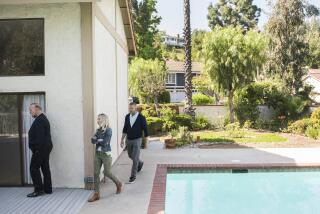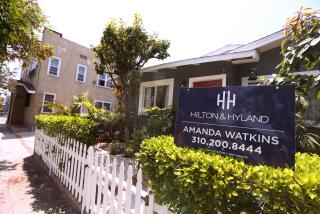Foreclosure pace nears decade high
Nearly 900 Californians a week are losing their homes because they can’t afford to pay the mortgage -- up from about 100 a week a year ago -- providing fresh evidence that the housing market’s troubles are nowhere near over.
The surge is raising concerns that home prices will soon suffer as a result. The 11,033 foreclosures in the first three months of the year represent an 800% increase over the same period a year earlier.
In addition, 46,760 homeowners were sent default notices in the first quarter, DataQuick Information Systems reported Monday. A default notice is a warning from a lender to catch up on payments immediately or face eviction.
Foreclosures and default warnings are at their highest points in nearly a decade, the La Jolla-based real estate data tracker said.
So far, the effect on home values has been muted. But as the number of move-outs, evictions and forced sales continue to increase, some economists say they will soon start to push prices down.
First to fall will be the low-income communities where marginal loans proliferated, they say. The trend will spread like a virus to more affluent neighborhoods.
The most pessimistic think a housing bust will wound the economy.
“For this rise in foreclosures to be happening in the midst of a strong labor market is truly unique and scary,” said analyst Christopher Thornberg of Beacon Economics.
He predicts foreclosures will top out at four or five times the current level -- enough, he says, to either induce a recession or at least bring the economy to the precipice.
Other experts aren’t exactly optimistic but believe that the situation is more ambiguous. They say the state’s low unemployment rate of 4.8% and generally healthy economy will absorb trouble, up to a point.
“My gut is the correction we are seeing is regional and very spotty,” said Patrick Veling, president of Real Data Strategies in Brea.
Generally, the places with the cheapest housing in the state -- including the Inland Empire and Central Valley -- are faring the worst.
In Riverside and San Bernardino counties, the combined volume of foreclosures rose to 2,369 in the first quarter from 255 in the same period last year. The Central Valley, which includes Sacramento County, jumped to 3,039 from 286.
Another problem spot is San Diego County, where the 1,183 foreclosures is the highest since DataQuick began tracking this information in 1988. The county’s market peaked earlier than the rest of the state.
Los Angeles County, the largest housing market in the state, is surprisingly strong. The default rate is almost 60% below the first-quarter 1996 peak, DataQuick said.
Most of the loans going into default now were made at the peak of the housing boom in 2005, when some thought the good times would continue forever and lending standards were lax. Nearly 80% of loans made in the state in May 2005 for the purpose of purchasing houses had adjustable rates, a record high.
Many of these mortgages required the borrowers to put little or no money down, and lenders took their word for whatever income they said they made.
For a moment, everything was fine. Then housing prices stopped going up -- meaning that many of these borrowers did not have enough equity or income to refinance to a new loan. Others in foreclosure may be able to afford the payments, but have chosen not to make them because their homes are worth less than they paid.
Foreclosures peaked at 15,418 in the third quarter of 1996, at the tail end of the last big slowdown in the state. They bottomed out at 637 in the second quarter of 2005, as the most recent boom was cresting.
The peak for default warnings was in the first quarter of 1996, with 61,541. The 46,760 warnings reported for the first three months of this year is up 148% from the same period last year.
Compared with the mid-1990s, however, the state’s population and housing stock have grown modestly.
The sharp rise in foreclosures has become a political issue, with Congress debating methods of aiding those underwater.
There’s little precedent for the current wave of foreclosures. Traditionally, people lose their jobs, and then they lose their houses. In the early ‘90s, the aerospace industry’s collapsetriggered a broad recession.
This time, the foreclosures are happening first -- and fast.
“It surprises me, the speed at which all this is evolving,” said Edward Leamer, director of the UCLA Anderson Forecast.
He sees plenty to worry about. For instance, the recent tightening of loan standards is, for better or worse, eliminating a lot of the fuel that powered the bottom of the market. Entry-level buyers are priced out, which means existing owners have a harder time selling their homes to move up. Eventually, everyone is vulnerable.
“The housing sector is in trouble for a considerable period,” Leamer concluded, “but the rest of the economy will muddle through.”
In its March housing report last week, DataQuick reported that the median price for homes sold in Southern California was up 4.6% from March 2006 despite a sharp drop in sales.
Because the houses that aren’t selling tend to be the cheaper ones, that automatically pushes up the median. Housing bears say a rising median can mask a sinking market.
Even taking this into account, however, the market appears healthier than one might expect.
Sales in the three lowest segments of the market plunged by about 50% in March from March 2006, according to new DataQuick statistics. Yet the median prices in those categories were, on average, unchanged from a year earlier.
“Prices are going sideways,” said Veling of Real Data Strategies.
He wondered whether the mood was worse than the reality, adding that the boom went on so long that people’s memories are distorted.
“It’s been so long since we’ve seen a normal market that we’ve forgotten what it looks like,” he said.
*
(BEGIN TEXT OF INFOBOX)
Big jump
Mortgage foreclosures surged in the first quarter. A breakdown by county and region:
*--* Foreclosures in Change from a 1st quarter 2007 year earlier Ventura 203 +1,094.1% Riverside 1,460 +913.9 San Bernardino 909 +718.9 Los Angeles 1,702 +677.2 Orange 520 +676.1 San Diego 1,183 +673.2 Southern California 6,007 +733.1 Statewide 11,033 +802.1
*--*
--
Source: DataQuick Information Systems
--
Los Angeles Times
More to Read
Inside the business of entertainment
The Wide Shot brings you news, analysis and insights on everything from streaming wars to production — and what it all means for the future.
You may occasionally receive promotional content from the Los Angeles Times.










